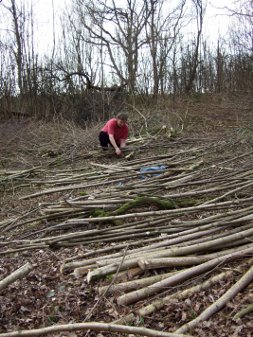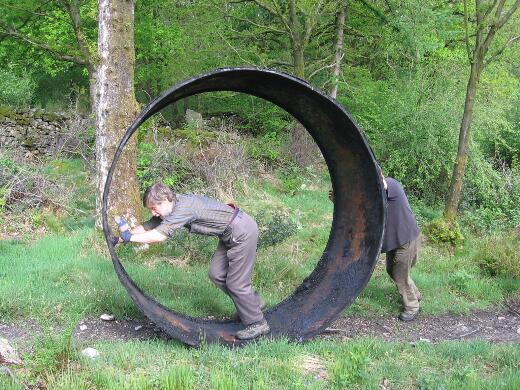
|
|
|||||
|
Coppicing
Coppicing is a traditional, sustainable and productive form of woodland management.
In a coppiced wood, trees are regularly cut off at ground level, causing many rods (rather than one large trunk) to grow from the stump or 'stool'. The rods that grow from the stool are straight and long and can be used for many crafts and products (see below). Most of our native trees will coppice well, with the most common species including hazel, ash, oak, birch, alder, and sweet chestnut (non native). A coppiced wood is cut on a cycle, which can be anything from 5 to 30 years, depending on the size of the poles required. The wood is divided into areas or 'coups', equal to the number of years in the cycle, so one area is cut each year until you are back to the beginning. The underwood (trees and shrubs to be coppiced) is cut and laid out to be sorted into different products. None of the wood is wasted, even the tops can be laid over the stools to discourage deer browsing. Coppicing is great for wildlife as it allows light into the woods, causing a burst of growth and flowering of the woodland plants, increasing the diversity of species and creating a variety of vegetation heights within the wood. A coppiced woodland will encourage a wide diversity of insects, plants and animals to flourish such as woodland edge butterflies; in a derelict coppiced woodland, many of these species are likely to disappear. The most usual coppicing system found in this area is called "coppice with standards". In this type of coppicing practice not all the trees in the coup are coppiced, allowing a number of trees to mature. However, there should not be too many standards left or the regrowth of the coppice will suffer from poor light levels. Although coppicing is a traditional way to manage woodlands, from the 1960's coppicing as a trade started to decline as modern, synthetic materials came in which were cheaper and more easily available. Sadly, throughout Britain there are acres of derelict coppice that badly need managing. However, there has recently been a resurgence of coppicing, as it is a totally sustainable and environmentally friendly woodland management system. Some uses for coppiced wood:
Sorting Rods

Sorting the hazel poles into different products
such as hedge stakes, hurdle rods, beanpoles, yurt poles, besom handles etc. (Click to enlarge) Moss and Height Spring Wood
 An interesting happening in woodland management took place in 2011. The Woodland Trust leased the management
of a twenty-hectare ancient woodland in the south of the Lake District to the Bill Hogarth MBE Memorial Apprenticeship Trust.
An interesting happening in woodland management took place in 2011. The Woodland Trust leased the management
of a twenty-hectare ancient woodland in the south of the Lake District to the Bill Hogarth MBE Memorial Apprenticeship Trust.
Read more... |
|||||

